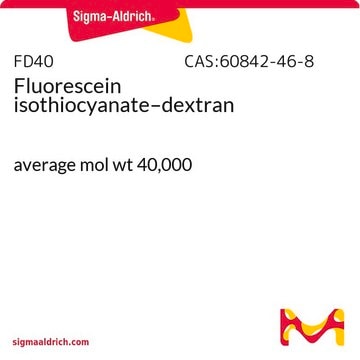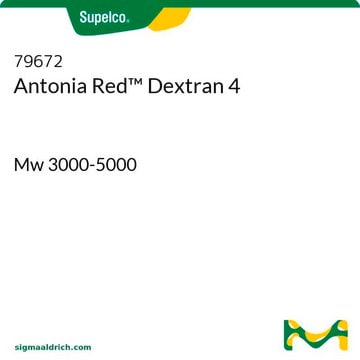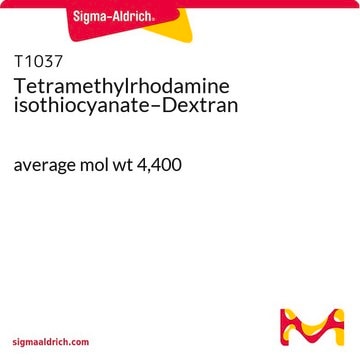If this product has an expiration or retest date, it will be shown on the Certificate of Analysis (COA, CofA). If there is no retest or expiration date listed on the product's COA, we do not have suitable stability data to determine a shelf life. For these products, the only date on the COA will be the release date; a retest, expiration, or use-by-date will not be displayed.
For all products, we recommend handling per defined conditions as printed in our product literature and website product descriptions. We recommend that products should be routinely inspected by customers to ensure they perform as expected.
For products without retest or expiration dates, our standard warranty of 1 year from the date of shipment is applicable.
For more information, please refer to the Product Dating Information document: https://www.sigmaaldrich.com/deepweb/assets/sigmaaldrich/marketing/global/documents/449/386/product-dating-information-mk.pdf
FD4
Fluorescein isothiocyanate–dextran
average mol wt 3,000-5,000
Synonym(s):
FITC–Dextran
Select a Size
Select a Size
About This Item
Recommended Products
biological source
synthetic
conjugate
FITC conjugate
form
powder
mol wt
average mol wt 3,000-5,000
extent of labeling
0.001-0.020 mol FITC per mol glucose
technique(s)
HPLC: suitable
color
light yellow to dark orange
solubility
H2O: 25 mg/mL
suitability
suitable for HPLC
suitable for fluorescence indicator
suitable for fluorescent labeling techniques
application(s)
life science and biopharma
metabolomics
microbiology
pharmaceutical
storage temp.
2-8°C
Looking for similar products? Visit Product Comparison Guide
General description
In biochemical investigations focused on the blood-brain barrier (BBB), FITC-Dextran, particularly the variant with an average molecular weight of 4000, holds a central role. It serves as a dependable tool for evaluating the permeability of solutes, ions, and proteins across the BBB, facilitating an improved understanding of the barrier′s integrity and any potential disruptions. This contribution to biochemical exploration is invaluable in shedding light on the brain′s defense mechanisms.
Additionally, FITC-Dextran plays a pivotal role in studies related to cell permeability within the area of biochemical research. This extends to the assessment of BBB permeability and the extent of disruptions within the BBB, aspects that are fundamental to neuroscience and drug delivery research. These biochemical research facets are essential for comprehending disease mechanisms and formulating effective therapeutic strategies.
Furthermore, FITC-Dextran is a cornerstone in cardiovascular, microcirculation, and perfusion studies. It operates as a fluorescent flux tracer compound, allowing for the measurement of critical processes like blood flow, membrane integrity, vascular drainage, and renal elimination. In conclusion, FITC-Dextran proves to be an indispensable asset in the fields of biology, biochemistry, and medicine, offering unparalleled insights into the intricacies of cellular and tissue permeability, the integrity of the blood-brain barrier, and the understanding of diverse physiological and pathological processes.
Application
- as a tracer molecule in membrane permeability study[1]
Biochem/physiol Actions
Features and Benefits
- Suitable for Biochemical and Biomedical research
- Versatile and adaptable for wide variety of laboratory and research applications
Preparation Note
Other Notes
comparable product
Signal Word
Warning
Hazard Statements
Precautionary Statements
Hazard Classifications
Eye Irrit. 2 - Skin Irrit. 2 - STOT SE 3
Target Organs
Respiratory system
Storage Class Code
11 - Combustible Solids
WGK
WGK 3
Flash Point(F)
Not applicable
Flash Point(C)
Not applicable
Personal Protective Equipment
Choose from one of the most recent versions:
Already Own This Product?
Find documentation for the products that you have recently purchased in the Document Library.
Customers Also Viewed
Articles
Explore FITC-labelled polysaccharides and their properties, including impact of molecular weight on molecule dimensions.
Related Content
Dextran is a polymer of anhydroglucose. It is composed of approximately 95% alpha-D-(166) linkages. The remaining (163) linkages account for the branching of dextran.
-
How can I determine the shelf life / expiration / retest date of this product?
1 answer-
Helpful?
-
-
How is shipping temperature determined? And how is it related to the product storage temperature?
1 answer-
Products may be shipped at a different temperature than the recommended long-term storage temperature. If the product quality is sensitive to short-term exposure to conditions other than the recommended long-term storage, it will be shipped on wet or dry-ice. If the product quality is NOT affected by short-term exposure to conditions other than the recommended long-term storage, it will be shipped at ambient temperature. As shipping routes are configured for minimum transit times, shipping at ambient temperature helps control shipping costs for our customers. For more information, please refer to the Storage and Transport Conditions document: https://www.sigmaaldrich.com/deepweb/assets/sigmaaldrich/marketing/global/documents/316/622/storage-transport-conditions-mk.pdf
Helpful?
-
-
What is the difference between FD4 and 46944?
1 answer-
Products FD4 and 46944 are essentially the same product, but they are offered for sale by different divisions. The primary difference between the two lies in the amount of FITC conjugated to the dextran (glucose). For FD4, the amount of FITC ranges from 0.001 to 0.020, while for 46944, the range is 0.002 to 0.020. It is important to note that individual lots must fall within these specified minimum and maximum values.
Helpful?
-
Active Filters
Our team of scientists has experience in all areas of research including Life Science, Material Science, Chemical Synthesis, Chromatography, Analytical and many others.
Contact Technical Service











